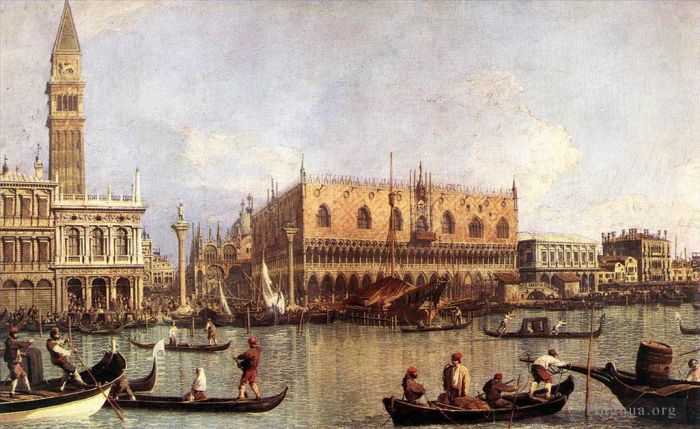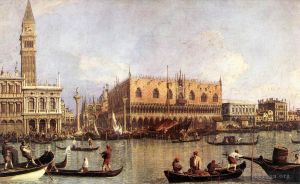Palazzo Ducale and the Piazza di San Marco
Canaletto
- Price: Price on Request
- Art Type: Oil Painting
- Size:
- English Comments: 0
- International Comments: 0
- Creating Date:
- Introduction and Works of Canaletto >>
Work Overview
- Palazzo Ducale and the Piazza di San Marco
CANALETTO
c. 1755
Oil on canvas, 51 x 83 cm
Galleria degli Uffizi, Florence
This view of the Wharf and the Riva degli Schiavoni taken from the Docks of San Marco, which from the Zecca and the Libreria Vecchia embraces the Ducal Palace and the Prisons as far as the Palazzo Dandolo (now the Albergo Danieli), is one which Canaletto repeated many times. Today we know of more than ten autograph versions, the most important of which are those showing the departure or arrival of the Bucintaur in the foreground instead of the ordinary plying of boats, as here.
It is highly likely that for this composition Canaletto used the "optical camera", an instrument which facilitated the control of perspective in such a wide and "unnatural" field of vision. The stamp of naturalness is produced in any case by the immediacy of the boatmen's movements and by the temporary balance created by the boats crossing.
The view is taken from the Bacino, directly in front of the Zecca. On the left are the Zecca and Libreria with the excessively slender Campanile behind. Beyond the Piazzetta, with both columns correctly placed, are seen the Torre dell’Orologio and the south flank of San Marco with only the western dome visible. Next is the Palazzo Ducale, drawn in exaggerated two-point perspective, and to the right, rapidly diminishing in size, the Prigioni and indications of the Palazzo Dandolo. Canaletto narrowed and heightened most of the buildings - especially the Palazzo Ducale, which should be much wider - to squeeze a panoramic view into a normally proportioned composition.
In front of the Palazzo Ducale are moored the Doge’s galleon, the fusta, covered with a striped awning, and the Bucintoro: the scene depicted is thus the Ascension Day celebration. It is likely that Canaletto here recorded the ceremony of 26 May 1729, the first Sensa at which the new gilded Bucintoro appeared. Although it had been used for the ceremony the previous year, the allegorical sculptures decorating the new Bucintoro had not then been gilded, and the excitement generated by the spectacle of 1729 must explain why Canaletto was commissioned to produce at least three large paintings of the scene soon thereafter: for the ambassador of the Holy Roman Emperor (a pair to a painting of The Reception of Conte Giuseppe Bolagnos at the Palazzo Ducale on 29 May 1729); for the French ambassador (Pushkin Museum, Moscow); and reputedly for Louis XV (Bowes Museum, Barnard Castle).
In all of these paintings the perspectival effects of the Palazzo Ducale are reduced, and the Doge’s galleon is greatly foreshortened to lessen its visual impact and thus give more prominence to the Bucintoro. The foreground boats are much larger, with incidental detail such as an imminent collision between two gondolas, and it is clear that in this drawing Canaletto simply jotted in a few boats without any thought of their final effect. A few years later Canaletto painted the scene again for Joseph Smith, flattening the perspective a little further and playing down the drama of the foreground boats.
- Copyright Statement:
All the reproduction of any forms about this work unauthorized by Singing Palette including images, texts and so on will be deemed to be violating the Copyright Laws.
To cite this webpage, please link back here.
- >> English Comments
- >> Chinese Comments
- >> French Comments
- >> German Comments
- >>Report
- Capriccio with ruins and porta portello in padua
- The women s regaton the grand canal
- The campo di rialto
- The Eastern Facade Of Warwick Castle
- Riva degli Schiavoni west side
- The piazzetta towards san giorgio maggiore
- Doge Palace
- Santa Maria Zobenigo
- Grand Canal
- San Giacomo Di Rialto
- The Piazzetta
- Capriccio with classical ruins and buildings
- Grand Canal From Santa Maria Della Carita To The Bacino Di San Marco
- Basilica di vecenza and the ponte de rialto
- Capriccio of a round church with an elaborate gothic portico in a piazza a palladian piazza and 1755
- Piazza San Marco Venice (Piazza San Marco with the Basilica)
- The Nave of San Marco looking East (San Marco the Interior)
- Warwick castle
- The Bucintoro Returning To The Molo On Ascension Day
- A Regatta on the Grand Canal
- Venice Viewed from the San Giorgio Maggiore
- View of the Ducal Palace
- Piazza san marco looking east
- The Bacino di San Marco on Ascension Day
- View Of the Entrance To The Arsenal
- Dolo On The Brenta Venetian Venice
- The Molo Looking West
- Palazzo Ducale and the Piazza di San Marco
- Grand Canal The Rialto Bridge From The South
- Scala dei giganti 1765
- The Riva Degli Schiavoni
- Rio Dei Mendicanti
- The interior of henry vii chapel in westminster abbey
- View of the grand walk vauxhall gardens with the orchestra pavilion the organ house the turkish
- Perspective View with Portico
- Stonemasons Yard
- View of the Bacino di San Marco St Marks Basin
- Perspective with a portico 1765
- The thames with st pauls cathedral 1746
- Piazza San Marco 1730
- Reception Of The Ambassador In The Doges Palace
- Dolo on the brenta
- Return Of The Bucentoro To The Molo On Ascension Day
- The chapel of eton college 1747
- The Grand Canal From Rialto Toward The North
- The Grand Canal with the Rialto Bridge in the Background
- View Of Campo Santi Apostoli
- Perspective view with portico
- Capriccio of the grand canal with an imaginary rialto bridge and other buildings
- London Interior of the Rotunda at Ranelagh
- The Grand Canal looking East from Campo San Vio towards the Bacino
- The Fonteghetto Della Farina
- The Piazzetta towards S. Giorgio Maggiore
- The thames and the city of london from richmond house 1746
- Campo san rocco
- Night time celebration outside the church of san pietro di castello
- The Stonemasons Yard
- Canal Giovanni Antonio View Of The Grand Canal And Santa Maria Della Salute With Boats And Figure
- The Piazzetta towards Santa Maria della Salute
- Piazza San Marco The Clocktower
- Capriccio of a renaissance triumphal arch seen from the portico of a palace 1755
- Bacino di San Marco St Marks Basin
- San francesco della vigna church and campo
- Entrance To The Grand Canal Looking East
- Alnwick castle
- Piazza San Marco Looking Southeast
- Westminster abbey with a procession of knights of the bath 1749
- CANALETTO Grand Canal Looking Northeast From Palazo Balbi Toward The Rial to Bridge
- The Feast Day of St Roch
- Arrival of the French Ambassador in Venice
- CANALETTO Grand Canal Looking East From The Campo San Vio
- Capriccio Ruins And Classic Buildings
- The Entrance to the Grand Canal Venice
- A Regatta on the Grand Canal
- English Landscape Capriccio with a Column
- The dogana in Venice (Punta della Dogana in Venice)
- Santi Giovanni E Paolo And The Scuola Di San Marco 1726
- Campo santa maria formosa
- The Piazza San Marco in Venice
- San Cristoforo San Michele and Murano from the Fondamenta Nuove Venice
- The Grand Canal with Santa Maria della Salute looking East towards the Bacino
- Rome the arch of constantine 1742
- Santi Giovanni e Paolo and the Scuola de San Marco
- The Grand Canal near the Ponte di Rialto
- Venice Piazza San Marco and the Colonnade of the Procuratie Nuove









 Singing Palette
Singing Palette